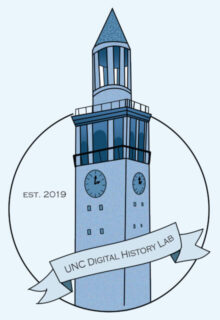By Gabriel Moss and Caroline Newhall
In 2019, the UNC Digital History Lab began hosting a series of “transcribathons.” In these events, history students and enthusiasts came together to transcribe historical documents, using a variety of online platforms to support research on Black soldiers during the Civil War, fugitive enslaved people in the 18th century, and the experiences of American soldiers during World War II.
2019 was a simpler time. The transcribathons were held in person, in sometimes crowded classrooms. As they worked, undergraduates, grad students, and faculty shared conversation and (perhaps as importantly) pizza. Such a format is obviously impossible during the current pandemic. Yet because a transcribathon relies on online transcription platforms, this type of exercise can easily be conducted remotely, exposing students to primary sources even amidst the closure of museums and archives, while simultaneously involving them in meaningful, publically-oriented historical research.
***
Crowd-Sourced Transcription (CST) is part of a broader “citizen science” movement, which seeks to engage the broader public in scholarly research. Using a suite of user-friendly web technologies, non-specialist volunteers help digitize historical documents: though the contributions of any individual volunteer are usually modest, crowd-sourcing allows these projects to efficiently process large amounts of data into accessible digital archives. In CST, professional academics and archivists typically provide leadership, quality control, and interpretive analysis of the finished data. However, this model of scholarship is premised on the belief that non-specialists, with minimal training, can make a meaningful contribution to academic work.
CST projects have produced impressive results, both in terms of scholarship and public engagement—Ben Blumfeld has written an excellent survey of the state of the field as of 2020. They also offer a promising pedagogical tool; in its CST Educator’s Guide, the Library of Congress notes that transcription work “can build students’ skills in close reading, examining historical context, and building interpretive consensus.” Transcription assignments put students in direct contact with primary sources, immersing students in the day-to-day trade of historians. Working with original documents, students build a visceral connection with the past and its inhabitants; in the words of Dr. Laura Morreale, an experienced innovator in teaching through transcription, “students appreciate [the text] as the work of another human, not just an abstraction of ideas on a printed page.”
***
Instructors who wish to use transcription in their classes will find a large and growing array of projects to choose from: Jaimie Fritz of Bentley University has produced a valuable list. None requires an extensive technological background. For history courses, good places to start include:
- By the People (Library of Congress)
- Smithsonian Digital Volunteers: Transcription Center
- Newberry Transcribe
- Zooniverse
- From the Page
- NYPL Public Projects
- Transcribe NC (State Archives of North Carolina)
***
By design, transcription projects can easily be mastered by non-specialists and technological neophytes—as digital teaching tools go, the barriers-to-entry for CST are minimal. The Library of Congress offers a straightforward how-to guide for hosting your own community or class transcribathon. It remains for instructors to thoughtfully use such projects to support their pedagogical objectives. By way of conclusion, let us offer three suggestions and a model lesson for integrating CST projects into your courses (with special attention to courses taught remotely).
- Bring in content experts.
The most successful DHL transcribathons benefited from the participation of subject-matter experts who helped students contextualize the documents they were working on. For example, during our transcribathon on Black Soldiers during the Civil War, Caroline shared her knowledge of African-American history in informal presentations and conversations with participants, as well as helping to coach them through the transcription process. Students appreciated having the opportunity to ask questions and explore the meaning and historical context of the documents.
To be sure, experts are not strictly necessary; the DHL held worthwhile transcribathons without them, and there is something to be said for the process of participants of all academic ranks and backgrounds muddling through the process together. Still, in our experience these events work best with specialist support. If the subject of a transcription project falls outside your academic wheelhouse, consider inviting a guest speaker (easier than ever in the world of Zoom and other video-conferencing platforms) in order to impart content-knowledge in addition to building historical skills.
- Develop classroom community.
Remote education, as we’ve all experienced, can be depersonalizing, anonymous, and downright lonely. While it is possible to assign CST projects for students to complete on their own—that is largely what the software is designed to facilitate—synchronous, virtual transcription events offer an opportunity to build classroom community in a fun, low-stakes setting. While sutdents work on their transcriptions, they can teleconference (or, if bandwidth is an issue, participate in a text chat), sharing interesting findings from their individual documents and collaborating on particularly difficult handwriting. If you’re lucky, student conversations may even stray off topic, approximating the valuable social atmosphere of the traditional classroom.
- Connect transcription and analysis.
Even as they engage in the relatively mechanical work of transcription, encourage your students to think about and discuss the interpretive questions raised by their documents. Consider pairing transcription with a writing assignment, asking your students to reflect on the process of working with archival documents, and to build a historical argument of their own based on the selection of sources they have read. As a model, consider the sample assignment below, assigned by Caroline for her course on 19th century American history.
Sample Assignment Student Instructions
Sample Assignment Teacher Guide
***
As most historians will tell you, there is a thrill to archival work, to being the first modern observer to lay eyes on a text. Once the prerogative of professionals, crowd-sourced transcription allows you to bring this experience into your own classroom (or its virtual equivalent). Even from afar, easy-to-use digital tools allow you to integrate transcription into your teaching.
